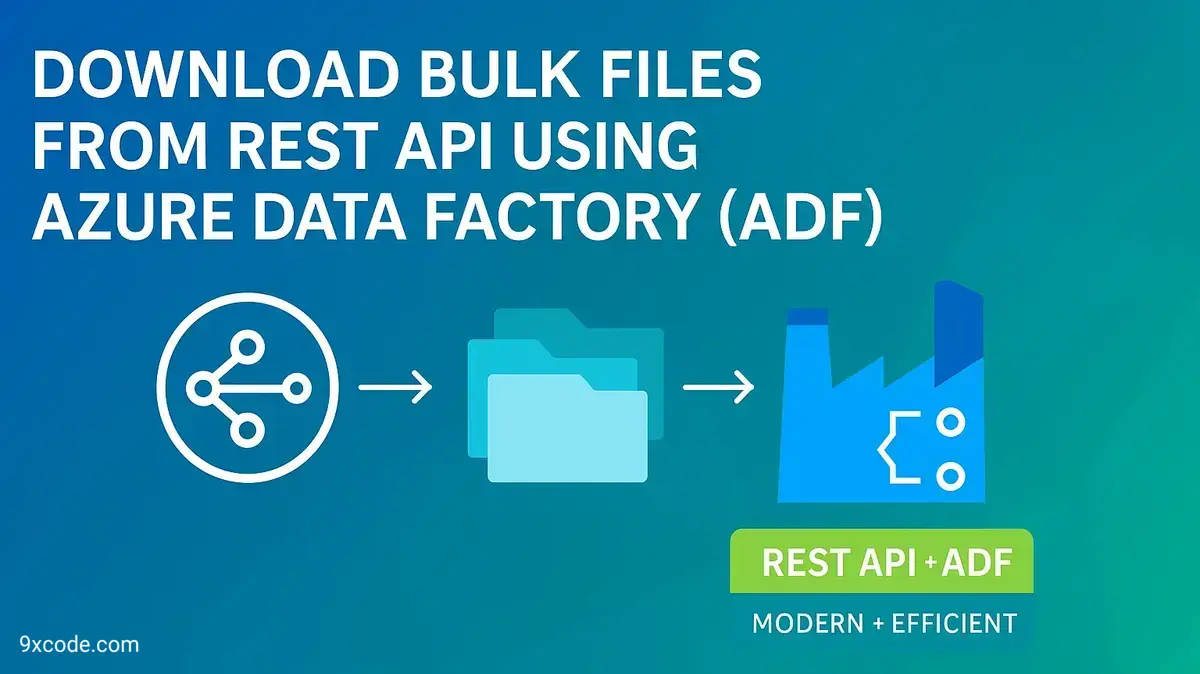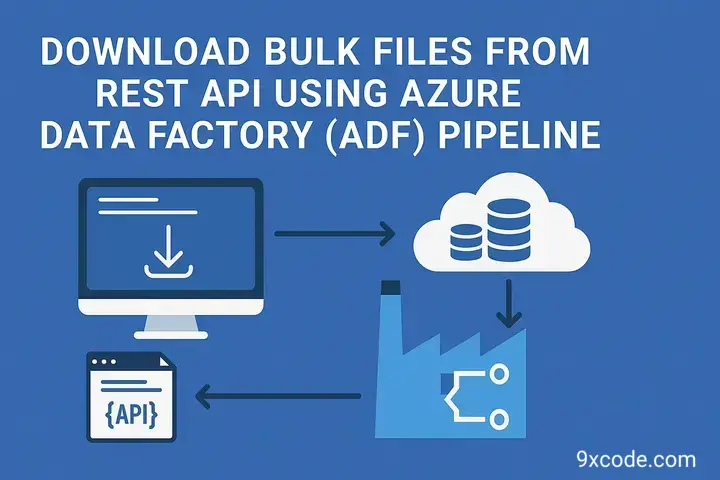Need to download a few files from an API? A simple script works. But what happens when scaling to hundreds or thousands of daily files, reports, user exports, or log files?
Doing this manually or with basic scripts, It becomes unmanageable. They’re slow, error-prone, and fail to restart after interruptions.
That’s where Azure Data Factory (ADF) pipelines come in. They give you a robust, manageable way to automate downloading bulk files from REST APIs directly into cloud storage like Azure Blob or ADLS Gen2.
Contents

Why ADF Dominates Bulk REST Downloads
Handle Multiple Files Easily
Azure Data Factory (ADF) dynamically allocate resources, so that process thousands of files in parallel without manual integration. Also, enabling parallel copy (up to 80 threads) to download bulk files and intelligently throttling to avoid API overload. Scripts typically fail beyond 500+ files, instead use ADF can process 100k+ files.
Download Management
People keep facing problems like failed download, starting download from scratch, or error while downloading file and stops download. ADF automatically manages these issues, we don’t need to do anything. Automatically retries for failed download, resume from where we have paused (dynamic allocated), and handle all error if normal otherwise notify if some issue occurred.
File Management
It can automate multi processed in single pipeline. Example: Manage Authentication process via OAuth tokens or Azure AD Credentials. Dynamically name or store files. Automatically trigger pipelines when new files arrived.
Activity Logs and Live Monitoring
Can see all the logs of process happening behind, Live monitoring to track downloads, audit trails for checking status of API activities, and get alert notification while something’s error or issue occurred.
Secured Data Transform
Native Azure integration directly saves file to Blob/ADLS Gen2, without using interim scripts. It manages all compliance automatically like encryption, policies implementation, and folder structures.
From above given points, it’s clear that Azure Data Factory is the best tool to download bulk files from REST API.
Building the ADF Pipeline and Download Bulk Files (Step by Step)

Main part of the article to discuss process of downloading files from REST API. Here, we have discussed how to build a pipeline for download files from REST API. Also, we have provided the examples for your understanding reference after this topic. Let’s start the step-by-step process.
Step 1: Map API Requirements
Determine file listing endpoint (GET/files), download endpoint pattern (GET/files/{id}/content), authentication method (API keys, OAuth), rate limits and pagination rules.
- File listing endpoint:
GET /files - Download pattern:
GET /files/{id}/content - Authentication: API keys, OAuth 2.0, or Azure AD
- Constraints: Rate limits, pagination rules (
next_page_token)
Step 2: Fetch File List (Handling Pagination)
Initially request arrived, fetch first page metadata to get knowledge of data arrived. Now, implement loop to collect all pages, handle continuation token (next_page_token), and manage offset. Parse the received data and extract identifiers, filenames, size information, last modified stamps and more necessarily.
REST API splits the file list across multiple pages. When you get the first page, and then until loop to iterate, next page token need to be linked. That why handle pagination by chaining activities that process the next link until none remains.
// ADF Web Activity pseudo-logic
string nextPageToken = "";
List<FileMetadata> allFiles = new();
do {
var response = GET($"https://api.com/files?token={nextPageToken}");
allFiles.AddRange(response.Items);
nextPageToken = response.NextPageToken;
} while (!string.IsNullOrEmpty(nextPageToken)); ADF automatically manages continuation tokens via Until loops.
Step 3: Configure Azure Storage
Manage directory hierarchy /{data}/{file_type}, files naming conventions {id}_{origial_name}.ext, or handle special character. File status tracking for passed/failed attempt or resume point. File storage capacity planing required for overloading management.
- Path structure:
/{data-type}/{YYYY-MM-DD}/{file_id}.ext - Naming: Avoid special characters using
@{replace(fileName, ':', '-')} - Capacity planning: Enable auto-scaling on storage account
Step 4: Download Files (Parallel + Error-Handling)
// ADF Copy Activity Configuration
"source": {
"type": "RestSource",
"paginationRules": {
"AbsoluteUrl": "$.nextPage"
},
"retryPolicy": {
"count": 5,
"intervalInSeconds": 30
}
},
"sink": {
"type": "AzureBlobStorage",
"folderPath": "sales-data/{DateTime.Now:yyyy-MM-dd}"
} Step 5: Resilience Implementation
Resilience implement for retry strategy (max-retry, delay in each retry), error handling (try-catch for network, API), state persistence (continuously saving), integrity verification (size validation, comparison) and more.
Parallel Processing
- Rate limiting
- Resource management: File handle limits, and memory caps for buffer.
- Concurrency Control: Thread counts to manage process or use dynamic queue.
Also read: If you want to become Fabric Data Engineer so here is complete roadmap for Microsoft DP-700 Certification Exam
Troubleshooting Common Issues
| Problem | Solution |
|---|---|
| HTTP 429 (Too Many Requests) | Reduce parallelism; add 10s delay |
| Binary files corrupted | Set "format": {"type": "Binary"} |
| Auth token expiry | Use Managed Identity with OAuth refresh |
| Partial downloads | Enable checkpointing in ForEach loop |
FAQ: Expert Insights
How to prevent JSON/CSV parsing in Copy activity?
In Copy Activity, set Source and Sink formats to Binary to prevent JSON/CSV parsing.
How to automate downloads when new files arrive?
Schedule pipeline runs, Event grid trigger, and API pulling helps to automate download when new files arrived.
How to handle 100 MB+ files?
Enable chunking with enablePartitionDiscovery=true.
Conclusion
Azure Data Factory resolved problems of downloading bulk amount of files from REST API. Support dynamic pagination, binary handling, and resilience features. The above approach not only guarantees complete and auditable file transfers at scale but also frees engineering teams to focus on high-value data utilization rather than pipeline maintenance. Implement the pipeline pattern above, with dynamic pagination and Key Vault integration to turn error-prone manual processes into scheduled, hands-off operations. Explore Microsoft’s ADF documentation for advanced tuning.